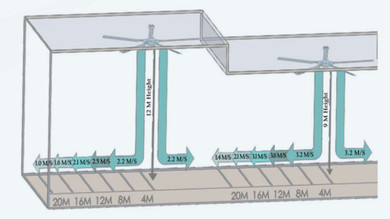Indoor air quality refers to the air inside the buildings as represented by the concentration of pollutants and thermal conditions. The quality of air in the working environment has an important role in the productivity and overall health of a person. However, most people don’t have an idea about the quality of the air they breathe in the workplace. The average person takes between 17,000 - 30,000 breaths per day, which means that the air quality in the work environment has a crucial impact on human health.
This blog emphasizes how important it is to maintain indoor air quality for workers and employees and how HVLS fans can help to improve indoor air quality.
Bad air quality can have adverse effects on human health in the working environment and has a huge impact on performance. Air pollutants are invisible, but prolonged exposure to bad air quality can cause serious health issues such as respiratory diseases.
- Acute effects - These are the effects that occur immediately after exposure. This may result in temporary issues like sneezing, dry throat, and many other health consequences. These effects may not be long-lasting and may disappear shortly but may also cause serious damage at times.
- Chronic effect - These are long-lasting impacts to the frequently repeated exposures which can be fatal to the human body.
- Discomfort - This is typically associated with climatic conditions inside the building. The extreme pollutants inside the building may hinder employee’s performance which may result in absenteeism, employee health and will lead to affect the productivity of the company.
All these problems can be avoided by simply maintaining good indoor air quality.
HVLS fans are typically mounted from the ceiling support structure to provide maximum benefits. Depending on the overall building layout, including obstructions, there are a number of factors to consider when deciding how and when to use HVLS fans. For example, smaller diameter fans are the most effective in specific work areas or where installation space is limited.
HVLS fans are earning a reputation as a key component in not only regulating temperature but also defeating air particulate contamination and stagnant air. A consistent gentle air movement greatly diminishes bacteria, viruses, pollutants, and contaminants at the workplace. They have the ability to gently mix the air and create optimal airflow through destratification. By mixing heat-stratified layers of air, HVLS fans make the workplace more environmentally friendly, significantly improving employees’ comfort and health in all seasons while providing additional benefits in buildings with no air conditioning. They also help to reduce energy consumption, combat air quality-related problems, and even can be integrated into fire prevention systems.
In hot and humid conditions HVLS fans guard the facilities against heat stroke, heat exhaustion, and other heat-related problems, by providing workers with an evaporative cooling sensation, reducing the effective temperature.
HVLS fans are also beneficial in cold temperatures as they mitigate the rising heat effect by de-stratifying layers of heated air, gently circulating the warm air from the ceiling back towards the employees on the floor.
Summary
During extreme weather conditions inside the warehouses and industries where the humidity level inside the building can soar up the conditions, this not only affects the air quality but also makes working conditions very uncomfortable for employees which can cause serious concern for workers’ health and safety and also undermine productivity. The sole goal is to increase the comfort level for the warehouses that lack AC, decreasing the cooling cost. Here HVLS fans offer a wide range of solutions for meeting these objectives.

